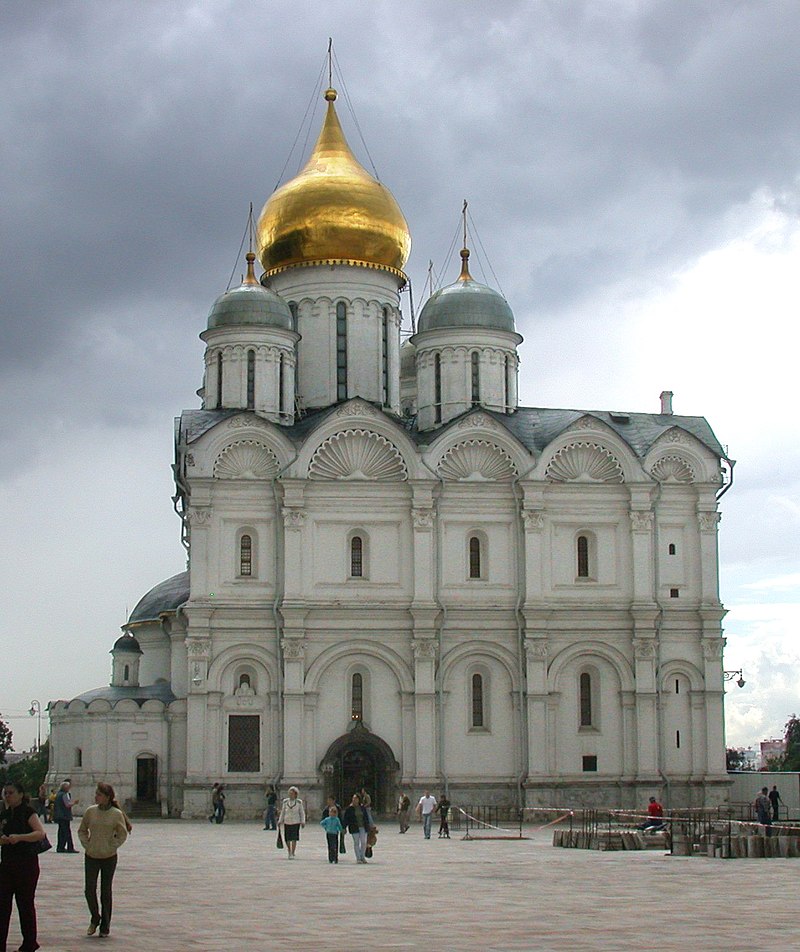by Susan Flantzer © Unofficial Royalty 2018
Agaphia Semenovna Grushevskaya, Tsaritsa of All Russia
Patron Icon of Feodor III and Agaphia Semenovna showing the saints Fyodor Stratilat and Great Martyr Agafia; Credit – Wikipedia
Born in 1663, the first wife of Feodor III, Tsar of All Russia, Agaphia Semenovna Grushevskaya was one of the three daughters of the noble Semyon Feodorovich Grushetsky and his wife Maria Ivanovna Zaborovskaya.
Agaphia Semenovna had two sisters:
- Anna Semenovna, married Tsarevich Vasily Alekseevich of Siberia
- Fyokla Semenovna, married Feodor Semenovich Urusov
Agaphia Semenovna was educated in a Western manner and could speak Russian, Polish, French, and Latin, and play the harpsichord. When she was 14 years-old, Agaphia was sent to live with her maternal uncle Semyon Ivanovich Zaborovsky, who did not wish her to marry. However, on Palm Sunday in 1680, 18-year-old Feodor III, Tsar of All Russia saw Agaphia in the crowd and made inquiries about her. Aware that her uncle did not wish her to marry, Feodor arranged a bride-show, a custom of Byzantine emperors and Russian tsars to choose a wife from among the most beautiful maidens of the country. Of course, Feodor chose Agaphia Semenovna. The couple was married on July 28, 1680, at the Assumption Cathedral in the Moscow Kremlin.
Sometime in early childhood, Feodor was disabled by an unknown disease that left him disfigured and partially paralyzed. However, Feodor was very intelligent, received an excellent education, and had been exposed to the Western European way of life. Agaphia had a strong influence on her husband and played a significant role in court life. Feodor was the first Russian tsar to wear Western dress and to cut his hair and beard. Traditionally, Russian noblewomen lived in the terem, separate living quarters, and were prevented from socializing with men outside their immediate family. Agaphia openly appeared before people and often sat and walked next to the tsar, something that had never happened before.
On July 21, 1681, Agaphia gave birth to a son Tsarevich Ilya Feodorovich. Sadly, Agaphia died of puerperal fever (childbed fever) three days later at the age of 18. Tsarevich Ilya Feodorovich survived his mother by a week. Feodor III was so grief-stricken that he was unable to attend his wife’s funeral. Agaphia was buried at the Ascension Convent, a Russian Orthodox nunnery in the Moscow Kremlin where royal and noblewomen were buried. In 1929, the Ascension Convent was dismantled by the Soviets to make room for the Red Commanders School. At that time, the remains of those buried there were moved to the crypt of the Archangel Cathedral in the Moscow Kremlin.

Ascension Convent, Agaphia Semenovna’s original burial place; Credit – Wikipedia

Archangel Cathedral, Agaphia Semenovna’s current burial place; Credit – Wikipedia
Marfa Matveyevna Apraksina

Marfa Matveyevna Apraksina; Credit – Wikipedia
Marfa Matveyevna Apraksina was the second wife of Feodor III, Tsar of All Russia. Born in 1664, she was the daughter of Matvey Vasilyevich Apraksin and Domna Bogdanovna Lovchikova. Marfa had three brothers who all became statesmen and military commanders under Peter the Great.
- Pyotr Matveyevich Apraksin (1659 – 1728), married (1) Princess Stepanida Matveyevna Obolenskaya, had four children (2) Princess Natalia Alekseevna Lvova
- Feodor Matveyevich Apraksin (1661- 1728), married Domna Bogdanovna Khrushcheva, no children
- Andrey Matveyevich Apraksin (1663 – 1731), married Akulin Fedorovna, had two children
At the beginning of 1682, Ivan Yazykov, a friend of Feodor III, suggested that the tsar marry Marfa, expecting his situation at court to improve. Feodor married Marfa Matveyevna Apraksin on February 24, 1682. However, the marriage lasted a little more than two months. Feodor III, Tsar of All Russia died on May 7, 1682, aged twenty, childless, and without making an order concerning the succession to the throne. His death triggered the Streltsy Uprising of 1682, a struggle for the succession between the families of the two wives of Feodor’s father Alexei I. This was eventually resolved by the decision to have two tsars at the same time – Feodor’s brother Ivan V and his half-brother Peter I under the regency of Sophia Alexeevna, the eldest surviving daughter of Alexei I and his first wife.
Marfa never remarried but remained a widow for the rest of her life. She lived in Moscow and then in St. Petersburg in her own palace, at the corner of the Admiralty Square and the Nevsky Prospect. With her skillful behavior, Marfa created a position for herself at the court of Peter I (the Great), her husband’s younger half-brother. Keeping Peter’s trust and respect, she received a financial allowance for the rest of her life and did not engage in the intrigues of political life.
Marfa Matveyevna died in St. Petersburg on January 11, 1716, and was buried in the entrance of Peter and Paul Cathedral at the Peter and Paul Fortress in St. Petersburg, the fourth Romanov buried at the not yet finished cathedral.
This article is the intellectual property of Unofficial Royalty and is NOT TO BE COPIED, EDITED, OR POSTED IN ANY FORM ON ANOTHER WEBSITE under any circumstances. It is permissible to use a link that directs to Unofficial Royalty.
Romanov Resources at Unofficial Royalty
- Tsardom of Russia/Russian Empire Index
- Romanov Births, Marriages and Deaths
- Romanov Burial Sites
- Romanovs Killed During the Russian Revolution
- Romanovs Who Survived the Russian Revolution
Works Cited
- https://de.wikipedia.org/wiki/Agafja_Semjonowna_Gruschezkaja
- De.wikipedia.org. (2017). Marfa Matwejewna Apraxina. [online] Available at: https://de.wikipedia.org/wiki/Marfa_Matwejewna_Apraxina [Accessed 13 Dec. 2017].
- En.wikipedia.org. (2017). Agafya Grushetskaya. [online] Available at: https://en.wikipedia.org/wiki/Agafya_Grushetskaya [Accessed 13 Dec. 2017].
- En.wikipedia.org. (2017). Marfa Apraksina. [online] Available at: https://en.wikipedia.org/wiki/Marfa_Apraksina [Accessed 13 Dec. 2017].
- Lincoln, W. Bruce. (1981). The Romanovs: Autocrats of All the Russias. New York, NY.: Doubleday.
- Ru.wikipedia.org. (2017). Грушецкая, Агафья Семёновна. [online] Available at: https://ru.wikipedia.org/wiki/%D0%93%D1%80%D1%83%D1%88%D0%B5%D1%86%D0%BA%D0%B0%D1%8F,_%D0%90%D0%B3%D0%B0%D1%84%D1%8C%D1%8F_%D0%A1%D0%B5%D0%BC%D1%91%D0%BD%D0%BE%D0%B2%D0%BD%D0%B0 [Accessed 13 Dec. 2017].
- Ru.wikipedia.org. (2017). Апраксина, Марфа Матвеевна. [online] Available at: https://ru.wikipedia.org/wiki/%D0%90%D0%BF%D1%80%D0%B0%D0%BA%D1%81%D0%B8%D0%BD%D0%B0,_%D0%9C%D0%B0%D1%80%D1%84%D0%B0_%D0%9C%D0%B0%D1%82%D0%B2%D0%B5%D0%B5%D0%B2%D0%BD%D0%B0 [Accessed 13 Dec. 2017].
